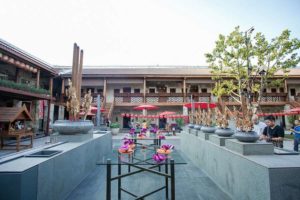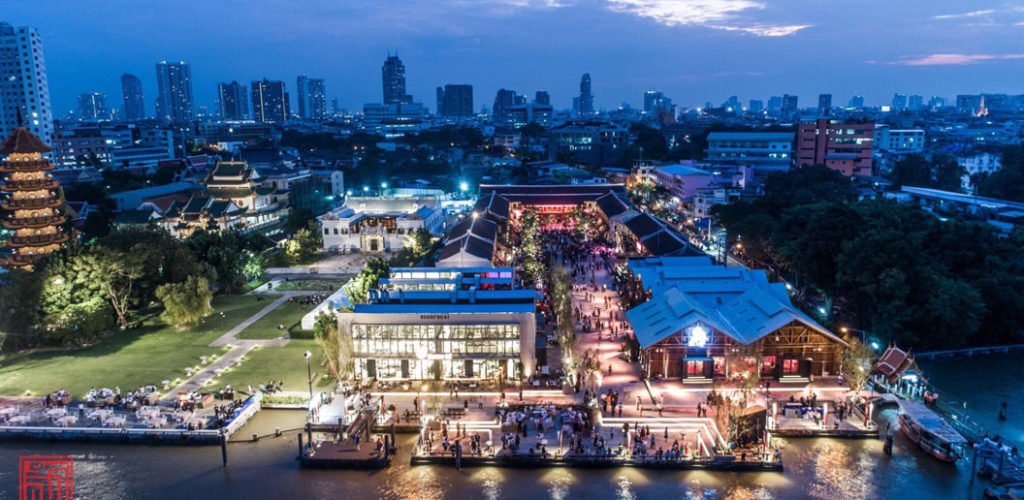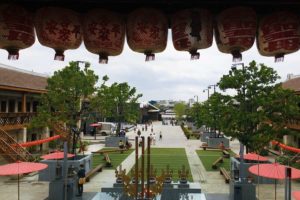 The art of reviving old cultural relics is something people have been doing for years, decades and centuries. In Bangkok, a rapidly developing mass urban setting, it could be easy – and in many cases even forgivable – to think that every old brick is being knocked over to make way for the towering edifications that loom tall over the city, further cementing its increasing reputation as a concrete jungle. But this is definitely not always the case. One of the exceptions to the rule, in what was previously a worn down 2.4 acre complex by the vicinities of the Chao Phraya River. is Lhong 1919.
The art of reviving old cultural relics is something people have been doing for years, decades and centuries. In Bangkok, a rapidly developing mass urban setting, it could be easy – and in many cases even forgivable – to think that every old brick is being knocked over to make way for the towering edifications that loom tall over the city, further cementing its increasing reputation as a concrete jungle. But this is definitely not always the case. One of the exceptions to the rule, in what was previously a worn down 2.4 acre complex by the vicinities of the Chao Phraya River. is Lhong 1919.
Lhong 1919’s history dates back to the 19th century. It was founded in 1850. Back in the day, Sino-Thai merchants who made their homes on the banks of the river, were in charge of the trade that circulated through the Chao Phraya. But while this was their primary base, Lhong 1919 was most importantly a hub for trade. The place was compared to an international port of sorts, which drew people from all corners of the continent as they looked to strike deals within the flourishing economy that was the Kingdom of Siam.
Founded by a man of the nobility who lived during the reign of King Rama V, it quickly became a symbolic market for traders. The nobleman Huay Chong Lhong, was an investor in steamboats and his name translates in Chinese to Steamboat Pier. It would fall into disuse after the Port Authority acquired its shares and was all but forgotten, until it was bought again by the notable Wang Lee family.
 Currently under their ownership, Lhong 1919 sits right in front of the famous Wang Lee mansion which is open for the public to visit. At the site, those who wish for success and riches can ask for luck at the Mazo Shrine, which is 167 years old. At its point of greatest splendour back in the day, the Chinese merchants who congregated on the banks of the river would pray to the gods for fulfilment in their endeavours and undertakings. It was at one point a major beacon of significance for Thai people of Chinese origin, who would hold important gatherings and ceremonies at Lhong 1919. In fact, so important was the pier, that it received a state visit of Empress Xi when she travelled to the Kingdom of Siam on an official state visit to King Rama V. Well wishers allegedly flocked to the river banks where they played out performances of Chinese opera, also known as ngiew, and filled with Toh Chin, which translates to Chinese Tables in Thai.
Currently under their ownership, Lhong 1919 sits right in front of the famous Wang Lee mansion which is open for the public to visit. At the site, those who wish for success and riches can ask for luck at the Mazo Shrine, which is 167 years old. At its point of greatest splendour back in the day, the Chinese merchants who congregated on the banks of the river would pray to the gods for fulfilment in their endeavours and undertakings. It was at one point a major beacon of significance for Thai people of Chinese origin, who would hold important gatherings and ceremonies at Lhong 1919. In fact, so important was the pier, that it received a state visit of Empress Xi when she travelled to the Kingdom of Siam on an official state visit to King Rama V. Well wishers allegedly flocked to the river banks where they played out performances of Chinese opera, also known as ngiew, and filled with Toh Chin, which translates to Chinese Tables in Thai.
The former of the two, an art which today has mostly been lost, was brought back to life for the new awakening of Lhong 1919. Ngiew was in its hay day the prime source of entertainment for the majority of the Thai Chinese population. Having been brought from mainland China, ngiew, which combines ancient Chinese literature, dance, song, music and martial arts into a boastful display of colours, masks and succinctly choreographed performances was one of the greater works of art that saw a re-emergence amongst the hipster crowd that mostly attended the opening day of the remodelled age old pier.
On its opening day back in November 2017, Lhong 1919 drew masses of people in an event well anticipated due to its marketing campaign. The pier, which had been all but forgotten by the soul of a city which a long time ago shifted away from this former central business district, was again alive.
And they were very far from disappointed. Activities at Lhong 1919 were plentiful, which – though having catered to the commercialised necessities of the 21st century – remains a hub that draws from the essence of the most classic Chinese influence. More than two hundred years of history are embodied in its refurbished architecture, which make it a fantastic place in which to reminisce and meditate on the influence the pier had back in the day. But for those who prefer keeping memories of the visuals, Lhong 1919 is currently one of the more photogenic spaces in town, making it the perfect place for those who live for the camera. From amateur selfie enthusiasts to professional or dedicated photographers, the places boasts an air of the mysticism for which it was once known.
The décor is admirable. Deliberately faded murals which disappear out into the background, demonstrate through classic Chinese art styles the life they led when the spot occupied an important role in the kingdom’s economy. Some aspects have been subtly upkept by artist paying the utmost attention to detail, while others such as the doors and the window frames – which are made out of teak – have been left to display their original charm. The combination is striking, as even the more modern parts of this remodelling keep the essence of what it meant to represent. The faded old details mesh with the modern characteristically predominance of red, which exudes a vibrant and energetic setting. The result is a neat central court with shortly cut grass and new concrete paving combined with worn out walls to which are attached modern wooden staircases. If you want to admire from the ground, sit on one of the stylish wooden benches. Those are placed on the grass and look up to the main structure of the u-shaped complex. Etchings can be found on some of the older walls – these clearly drawn recently – which make them looks incredibly authentic and ancient.
Of course, the pinch of modernity has now translated into stalls, booths, restaurants and shops. These serve traditional Thai food, from snacks to desserts such as pancakes. They also serve drinks, selections of popular teas and the usual refreshments. Chains have made their mark: iBerry has a branch where they sell their usual selection of waffles, ice cream and other sweet treats. The vicinities are definitely not short of spaces where people can take a break and grab a bite or a take a few sips of something. On the shopping front, while the options aren’t immense, they’re definitely for the higher spenders. Eight local shops sell branded goods to attract the wealthier crowds, from expensive furniture and leather goods to clothing.
 Getting to Lhong 1919 is not the most convenient of commutes, as it will take a taxi ride from BTS station Saphan Thaksin or Krung Thon Buri. If you’re on a boat though, it’s advisable that you use Wat Thong Thammachat Pier. The plan is for the old pier – the one which once carried scores of business and wealth into the economy of the Siamese kingdom – to be made usable again and allow people easy access through a charming boat ride, just the way it was done in the old days by Chinese merchants and businessmen from around the continent. Now known as the Wang Lee pier, its opening is has yet to be announced but is due soon.
Getting to Lhong 1919 is not the most convenient of commutes, as it will take a taxi ride from BTS station Saphan Thaksin or Krung Thon Buri. If you’re on a boat though, it’s advisable that you use Wat Thong Thammachat Pier. The plan is for the old pier – the one which once carried scores of business and wealth into the economy of the Siamese kingdom – to be made usable again and allow people easy access through a charming boat ride, just the way it was done in the old days by Chinese merchants and businessmen from around the continent. Now known as the Wang Lee pier, its opening is has yet to be announced but is due soon.
All in all, Lhong 1919 represents the vivid essence of Thailand’s once flourishing pier, and recounts the history of the Thai Chinese’s former cultural settings through a modern eye and a fresh start. The space is open every day of the week from 10 o’clock in the morning until 10 o’clock in the evening. The famous 167 year old shrine is open from 8 o’clock in the morning to 8 o’clock in the evening. If you have yet to see the renewed look of the pier or if you have a strong interest in garnering knowledge about the history of the Thai Chinese people, Lhong 1919 is definitely a place worth going to.



